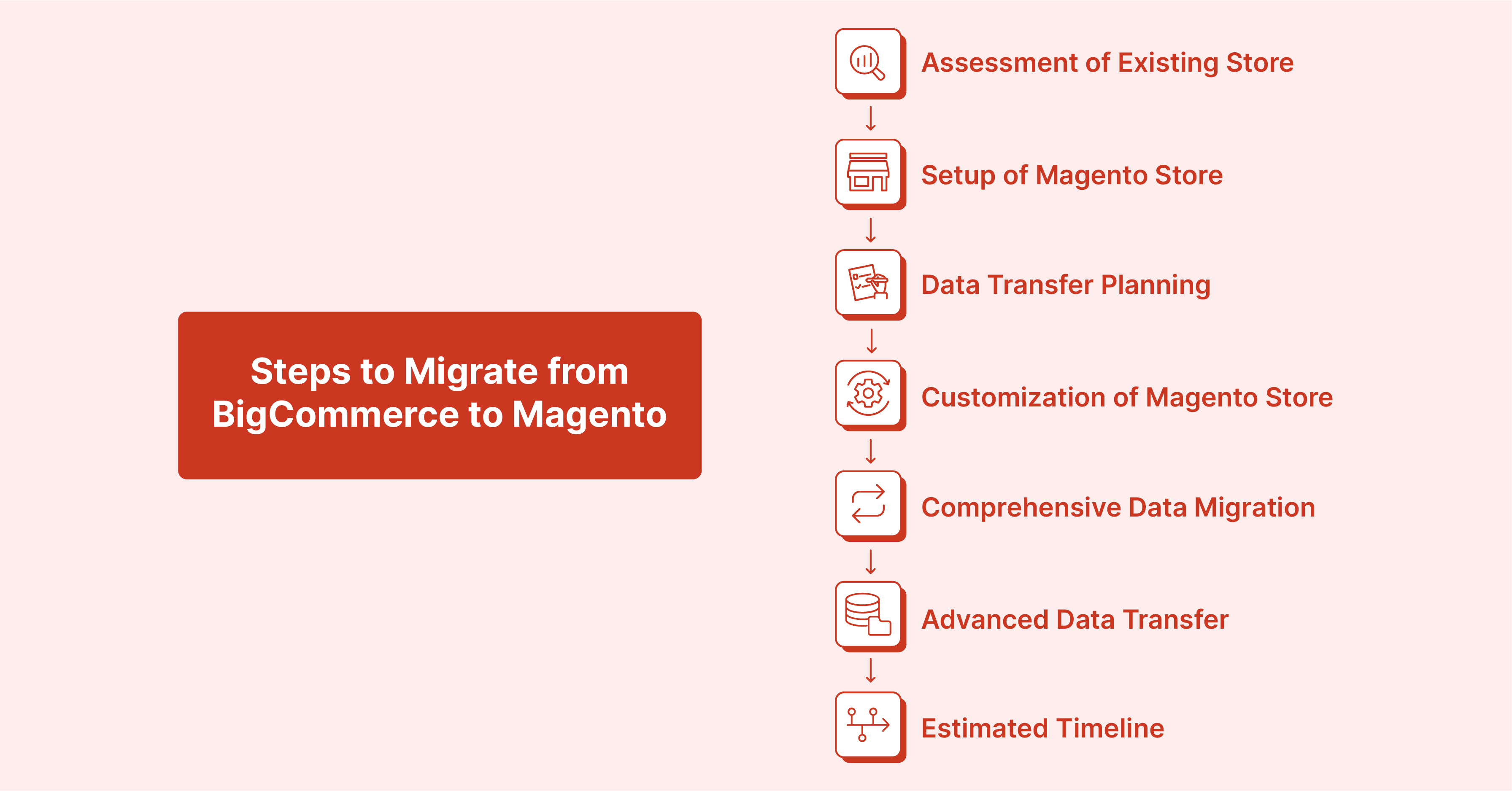
BigCommerce to Magento Migration: Benefits and Process
Migrating from BigCommerce to Magento includes exporting sensitive data—products, customers, and orders—from BigCommerce and importing it into Magento. The process demands meticulous planning and execution to guarantee a seamless transition for your online store, avoiding any loss of vital data or functionality. This guide will compare Magento and BigCommerce and explain why switching is beneficial. We'll also simplify the migration process to ensure your data and store operations transition smoothly.
Key Takeaways
-
Discover the strengths of BigCommerce and Magento as prominent eCommerce platforms.
-
Explore the reasons for migrating from BigCommerce to Magento, emphasizing Magento's flexibility, extensive customization options, and scalability.
-
Learn how to identify the right time for transitioning to Magento by considering essential factors.
-
Explore a comparative analysis between BigCommerce and Magento.
-
Learn how to execute a seamless migration from BigCommerce to Magento by following a step-by-step process.
-
Discover advanced migration considerations for a seamless transition between BigCommerce and Magento.
Introduction to BigCommerce and Magento
BigCommerce and Magento are two prominent eCommerce platforms. Each one offers tools and features, allowing businesses to establish and manage their online presence.
BigCommerce, as an eCommerce solution, empowers businesses to set up and run online stores easily. It simplifies creating a digital storefront and handling tasks such as product management, inventory control, and payment processing. BigCommerce is known for its user-friendly interface and various customization options.
Magento is a reliable and highly customizable e-commerce platform that has become the industry standard for online businesses. Developed in 2008, Magento offers many features and functionalities, making it ideal for small-scale startups and large enterprises.
It offers a user-friendly interface, payment gateways, extensive catalog management capabilities, and seamless integration. Magento also provides analytics and reporting tools, enabling businesses to gain valuable insights. It is particularly favored by businesses seeking high customization and scalability.
Why Consider Migrating from BigCommerce to Magento?
BigCommerce provides a user-friendly experience along with sufficient features to kickstart your business. While dependable and functional, it does have certain limitations when it comes to customization and scalability.
On the other hand, Magento stands out with its flexibility and extensive customization options. It enables businesses to create custom designs, integrate with a wide range of tools, and expand their reach on a global scale. Magento Open Source, in particular, grows alongside your business, effortlessly accommodating increased traffic and product offerings. Consider migrating to Magento if your business falls into one of the following categories.
-
Growth-Oriented Businesses: Magento becomes your strategic partner if your aspirations involve expanding product lines or venturing into global markets. It caters to businesses that have outgrown the capabilities of BigCommerce.
-
Businesses with Specific Requirements: Magento's customization capabilities provide a transformative advantage for those who value a store that mirrors their distinctive brand identity.
When Is the Right Time to Transition to Magento from BigCommerce?
-
Hitting BigCommerce's Limitations: As your product range expands or complexity increases, you may find BigCommerce's product management capabilities restrictive. Magento presents a more vast solution in such cases.
-
Customization Requirements: Magento offers greater flexibility when you feel constrained by BigCommerce's customization options. It can improve your storefront's visuals and streamline the checkout process.
-
Performance Challenges: Transition to Magento if you encounter issues like slower page loading times or struggle handling high traffic volumes. Magento's scalability and performance optimization tools can effectively address these concerns.
-
Business Expansion: If your plans involve global expansion, Magento's support for multiple languages and currencies makes it a better fit than BigCommerce. Magento’s advanced features are better suited for more intricate B2B or omnichannel retailing models.
BigCommerce vs Magento: A Comparative Analysis
1. Ease of Use

BigCommerce: Ideal for small businesses and startups seeking a quick and straightforward online presence setup.
- Simplified Dashboard: BigCommerce offers an intuitive dashboard, saving time on system navigation and allowing more focus on business management.
- Drag-and-Drop Functionality: Easily arrange your storefront with the drag-and-drop feature in BigCommerce Page Builder for non-technical users.
- Built-in Features: BigCommerce has various built-in features, reducing the reliance on external plugins.
Magento: Magento is feature-rich and suited for businesses with specific requirements. It is the preferred choice for those planning expansion or possessing the technical expertise to unlock its full potential.
- Customizable Product Types: Magento allows for the creation of complex product types. It includes configurable, bundled, and Magento grouped products, essential for stores with diverse product ranges.
- Advanced Customer Segmentation: The platform provides sophisticated customer segmentation options, enabling tailored marketing efforts based on customer behavior, purchase history, and preferences.
- Powerful Data Customization: You can create custom attributes for Magento products and customers in Magento. It is suitable for businesses needing detailed data management.
- Complex Rule-Based Product Relations: Set up intricate product relations based on predefined rules, such as displaying related products based on customer browsing history.
- Extensive API for Integrations: Magento’s API facilitates more complex integrations with third-party systems/ It is important for businesses requiring integration with ERP, CRM, or other business management tools.
2. Customization and Flexibility

BigCommerce:
- Pre-designed Templates and Themes: BigCommerce offers a range of templates and themes that can be partially customized. Users can make adjustments to colors, fonts, and basic layout elements.
- Style Editor: BigCommerce provides a Style Editor for making visual changes through a user-friendly interface for users lacking coding skills.
- Limited HTML and CSS Access: BigCommerce permits some HTML and CSS edits, but it's less extensive than Magento. While you can modify existing templates, creating entirely new or highly customized designs can be more challenging.
Magento:
- Fully Customizable Themes: Unlike BigCommerce, Magento allows you to build your theme entirely from scratch. This level of customization suits businesses seeking a fully unique online presence.
- Extensive HTML, CSS, and JavaScript Control: Magento grants you complete access to edit HTML, CSS, and JavaScript, providing the freedom to craft a highly tailored user experience.
- Advanced Product Customization: Magento excels over BigCommerce in terms of product customization. You can create intricate product options, custom attributes, and even personalized products, which BigCommerce's template-based system cannot match.
- Customizable Checkout Process: With Magento, you can tailor every aspect of the checkout process to optimize Magento conversion rates. This feature is less flexible and customizable in BigCommerce.
- Flexible Data Models: Magento's database structure allows for more complex data models and relationships. It is essential for businesses with intricate product catalogs and specific customer data requirements.
3. Scalability

BigCommerce:
- Suitable for Small to Medium-sized Businesses: BigCommerce is designed to cater to the needs of small to medium-sized businesses. It provides the necessary tools and capabilities for this scale.
- Product and Sales Volume Limitations: As your business grows, you may encounter limitations with BigCommerce. For example, when managing extensive product catalogs or experiencing a significant increase in sales volume. There are upper limits on efficiently handling the number of products and variants.
- Bandwidth and API Call Limits: BigCommerce plans have bandwidth limits and API call restrictions. It could become bottlenecks as your customer traffic and integration needs increase.
- Scaling Up Requires Plan Upgrade: To access more features and capabilities, you may need to upgrade to more expensive plans. This factor should be considered as your business grows.
Magento:
- Designed for Large-scale Operations: Magento is well-equipped to handle large businesses and those experiencing rapid growth.
- Highly Scalable Architecture: Magento's architecture allows seamless scaling without significant performance issues. You can confidently expand your product range, customer base, and transaction volume without worrying about the platform's ability to handle growth.
- Customizable for Performance Optimization: You can optimize the platform for performance with Magento. It includes setting up advanced caching mechanisms, optimizing the database, and tailoring server configurations to your needs.
- Support for Complex Business Models: Magento can accommodate various business models, including B2B, B2C, and hybrid. This versatility makes it an excellent choice for businesses evolving and diversifying their operations.
4. Pricing Structures

BigCommerce: BigCommerce offers a clear pricing structure with various tiers tailored to your feature requirements. Hosting is included in the pricing, making it a potentially cost-effective solution for small businesses. Total cost includes monthly subscription fees starting at $29.95/month, agency fees, expenses related to apps or extensions, and integration costs into other systems.
Magento: Magento necessitates a more substantial initial investment, especially when opting for Adobe Commerce (the paid version). While Magento itself is a free and cost-effective ecommerce solution, it's important to factor in hosting, development, and ongoing maintenance costs.
5. SEO and Marketing

BigCommerce: Built-in SEO and Marketing Tools: BigCommerce has built-in SEO features and user-friendly marketing tools, making it accessible for beginners.
Magento:
- Advanced Marketing Tools: Magento offers advanced SEO marketing tools, including customizable promotions, coupons, and incentives tailored to specific customer segments.
- Analytics and Reporting: Magento provides comprehensive analytics and reporting capabilities. It offers deeper insights into customer preferences, behavior, and sales trends compared to BigCommerce.
- Integration with Marketing Platforms: Magento's extensive API allows seamless integration with third-party marketing platforms. It offers a broader range of targeted marketing campaigns and customer relationship management options.
6. Hosting

BigCommerce: Use shared hosting provided by the platform, which is suitable for running large online stores and handling significant traffic.
Magento: Magento users enjoy the freedom to choose their hosting provider. However, it's essential to remember that the Magento hosting provider significantly impacts optimization and performance. Magento merchants are responsible for meeting PCI compliance standards and staying updated with patches and bug fixes for security.
7. Inventory Management

BigCommerce: Offers users limited inventory management and reporting features.
Magento: Provides expanded inventory management capabilities, including real-time stock visibility and automated stock forecasting based on previous sales. This advanced stock report offers insights into optimal stock levels, value, and popular products.
Steps to Migrate from BigCommerce to Magento

1. Assessment of Existing Store
Begin the migration process by comprehensively assessing your current BigCommerce store. It entails reviewing various elements, including product catalog, customer data, and essential product attributes. Understand the structure and organization of your store's data to prepare for a seamless transition. Automated migration tools like LitExtension can help move your online store from BigCommerce to Magento easily and quickly.
2. Setup of Magento Store
Once the assessment is complete, it's time to set up your new Magento store. This step involves configuring the Magento platform to align with your business requirements. Ensure that the store's settings, such as currency, language, and tax rules, are tailored to your needs.
3. Data Transfer Planning
To execute this step effectively, you must identify and select appropriate migration tools or services for transitioning from BigCommerce to Magento. Pay special attention to data mapping. Ensure information is accurately matched between the two platforms to prevent data loss or misplacement.
4. Customization of Magento Store
To create a seamless shopping experience for your customers, it's essential to customize your new store's Magento design and layout. This step involves aligning the store with your brand identity and optimizing the user experience. Explore using extensions or plugins to enhance functionality further, ensuring your store meets your specific needs.
5. Comprehensive Data Migration
The migration process involves a wide range of data, including:
1. Products
- Name, SKU, Full Description, Status, Manufacturer.
- Price, Special Price, MSRP.
- URL, Meta Title, Meta Keywords, Meta Description.
- Weight.
- Variants: (SKU, Weight, Attributes, Price, Special Price, Name).
- Additional Images.
- Stock Availability.
2. Product Categories
- Name, Description, Status.
- Thumbnail Image.
- URL, Meta Title, Meta Description, Meta Keywords.
3. Manufacturers
- Name
4. Customers
- First Name, Last Name, Email.
- Billing Address: (Address 1, Address 2, Country, State, City, Zip Code).
- Shipping Address: (Address 1, Address 2, Country, State, City, Zip Code).
- Orders
- Order Date, Order Status, Order Products: (Name, SKU, Option), Product Price, Quantity, SubTotal Price, Discount Price, Tax Price, Total Price, Order Comments Shipping Price.
- Customer Name, Email, Billing Address: (Company, Address 1, Address 2, Country, State, City, Zip Code, Telephone).
- Shipping Address: (Company, Address 1, Address 2, Country, State, City, Zip Code, Telephone).
5. Coupons
- Name, Coupon Code, Coupon Date.
- Reviews
- Created Date, Status, Rate, User Name, Title.
- CMS Pages
- Title, Created Date, URL, Description.
6. Advanced Data Transfer
Advanced migration tools come into play when transferring intricate data elements. It includes customer reviews, ratings, promotional campaigns, and customizations made within the BigCommerce platform. Leveraging these tools ensures no valuable information is left behind during the transition. Consider a Data Migration Service Package for an even smoother experience.
7. Estimated Timeline
While the duration of the migration process may vary, it's generally advisable to allocate a minimum of 2-4 weeks for the entire procedure. This timeline allows for thorough planning, data mapping, customization, rigorous testing, and final implementation. It's important to consider the complexity of your store and the volume of data to be migrated. Also, consider specific customization requirements that may affect the actual duration.
Advanced Migration Considerations for Seamless Transition
-
Clear Target Store Data Before Migration: Remove old data from your Magento store before migrating to ensure a fresh start and avoid complications. It ensures a clean slate for a trouble-free launch on Magento.
-
Preserve Order IDs on Target Store: Opt to retain original order IDs during migration for improved order tracking and customer service.
-
Implement 301 Redirects on Target Store: Utilize 301 redirects to guide customers and search engines from old URLs to new ones on your Magento store. It is important for maintaining strong SEO rankings post-migration.
-
Migrate Categories and Products SEO URLs: Transfer SEO-friendly URLs for categories and Magento products to preserve search rankings. It enhances SEO optimization with customizable links and metadata during the switch to Magento.
-
Preserve Customer IDs on Target Store: Maintain customer IDs for a seamless shopping experience and consistent data. It helps to retain buyer history and preferences during the transition.
-
Transfer Images: Ensure a consistent visual experience by moving images from products, categories, and blog posts. Visual content helps attract customers and provides detailed product views.
-
Set Products Quantity in Magento Store: Manage inventory effectively by setting all product quantities to 100 in your Magento store. It helps facilitate testing and monitoring of stock levels post-migration, preventing sales disruptions.
-
Smart Update Entities: Keep data up-to-date with the Smart Update feature, allowing for efficient management of changes in product inventory, order details, and customer information. Automate data synchronization for accuracy and efficiency in your Magento store.
FAQs
1. What is the best way to import product descriptions during migrating to Magento?
Use a reliable data migration tool like LitExtension to import product descriptions seamlessly. Ensure the tool supports the transfer of detailed product attributes, including descriptions, preserving the integrity of your online store.
2. How to test the transfer of customer groups from BigCommerce to Magento 2?
Before the actual migration, conduct a demo migration to test the transfer of customer groups. Follow the instructions provided by migration experts to validate that customer groups are accurately replicated in Magento 2.
3. How can store owners maintain data security policies during the migration process?
Store owners should choose migration services or tools that prioritize data security. Ensure that SSL encryption is employed. It secures the connection between the source store and the new Magento store, safeguarding sensitive information.
4. Can the downtime be minimized when migrating from BigCommerce to Magento?
Yes, there might be some Magento downtime during the migration process. To minimize it, schedule the migration during low-traffic periods. Collaborate with developers to optimize the process and choose solutions that offer speed and efficiency.
5. Can I migrate coupon names and their data from BigCommerce to Magento?
Yes, use a data migration tool that supports the transfer of coupons names and associated data. Ensure that the tool or service you select provides a seamless transition, minimizing disruptions to your marketing strategies.
6. What precautions should be taken to prevent issues with product IDs during migration?
Work with migration experts who understand the intricacies of transferring product data to avoid issues with product IDs. Verify that the data migration tool preserves and accurately transfers product IDs, preventing inconsistencies in your Magento store.
7. How can store owners maintain uptime for their online store during the migration?
Store owners can maintain uptime by choosing migration solutions that offer continuous data transfer. Opt for tools that support smart update entities to synchronize changes efficiently, ensuring minimal disruption to the live site.
Summary
Businesses often consider BigCommerce to Magento migration for Magento's flexibility, extensive customization options, and scalability. This guide covered the comparative analysis between BigCommerce and Magento. It also detailed the migration process and advanced considerations for a seamless transition to Magento store. Explore Magento server hosting options to optimize the performance of your migrated store. Leverage Magento’s features and capabilities for your online business.

